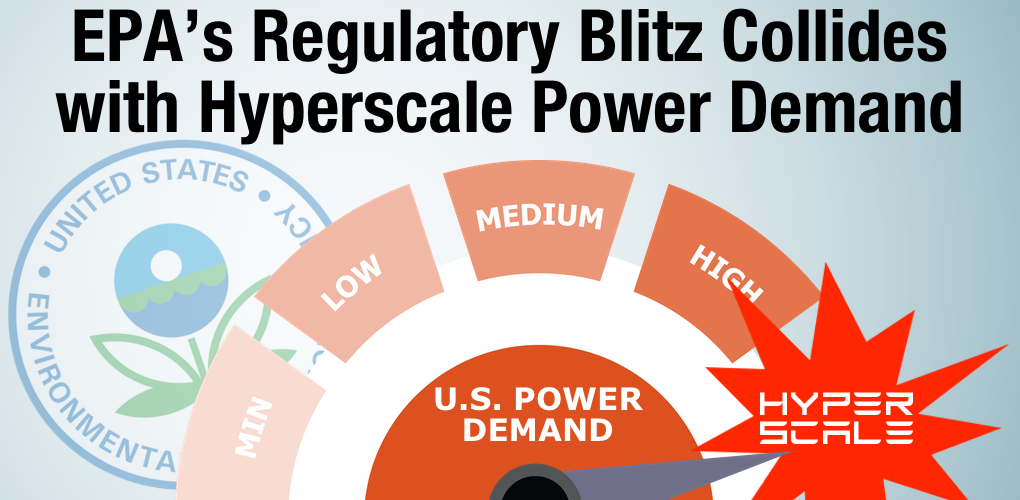
EPA’s Regulatory Blitz Collides with Hyperscale Power Demand
“You never like to have to sue, but we’re going to do what we have to do to defend our grid and our customers that use that grid,” Ben Fowke, American Electric Power (AEP) interim president, CEO and director, said during a recent earnings call.
Facing surging power demand, AEP – which serves 5 million customers in parts of 11 states – announced it’s likely to sue the U.S. Environmental Protection (EPA) over its blitz of rules targeting coal and natural gas generation.
Like so many other utilities across the country, AEP simply doesn’t see a viable path forward to maintaining grid reliability while meeting incredible load growth without the very power plants EPA’s is determined to force off the grid.
AEP has reported that companies representing 15 gigawatts of new power demand – mainly from data centers – are seeking new service from the utility by 2030. That amount of new demand is equivalent to the addition of 15 new nuclear power plants serving more than 10 million households. Astoundingly, AEP said “many, many” more gigawatts of demand are possible from hundreds of inquiries from potential customers.
When the North American Electric Reliability Corporation (NERC) reported in December that “key measures of future electricity demand and energy needs are rising faster than at any time in recent years,” it raised more than a few eyebrows. Now NERC’s warning and demand projects already seem far too conservative.
Electricity demand isn’t just rising quickly, it’s exploding across the country. In some regions it’s battery manufacturing or semiconductor production driving demand, but the explosive growth of data centers to service cloud computing and AI is seemingly upending demand projections nearly everywhere.
Not only are there more and more data centers planned but they’re getting far bigger with enormous power needs. New hyperscale data companies are building data center campuses that can support a full gigawatt or more of power demand. “Data centers are going to be very different,” said Ali Fenn, President of data center developer Lancium, at the recent Data Center World conference. “All of the requirements I’ve been discussing are 1 gigawatt and 2 gigawatts. The sheer size of what we’re talking about is unprecedented, with a much bigger physical footprint,” he said.
As The Wall Street Journal recently reported, for some new hyperscale data centers planned for Northern Virginia, which is a gateway for 70% of the world’s internet traffic, the biggest planned facilities will use as much power as the city of Seattle.
Dominion Power, the utility for much of Virginia, expects power demand in its service territory to jump 85% in the next 15 years. And that growth is hardly unique.
The Electric Reliability Council of Texas (ERCOT), the grid operator for most of the state, now estimates its peak summertime power demand in 2030 to hit 160,000 megawatts (MW), an unprecedented 40,000 MW higher than the expectation just a year ago.
In Texas, Virginia and dozens of other states, the simple and alarming question is: where is the power going to come from?
Reliability Impossibility
Meeting surging demand would be challenge enough but doing so while EPA dismantles the coal fleet by 2032, and has now effectively banned new baseload coal and natural gas generating capacity, seems an all but impossible hill to climb.
For the nation’s utilities, reliability regulators and President Obama’s Secretary of Energy, Ernie Moniz, trying to move the nation’s supply of power off fossil fuels by 2035 – as the Biden administration has stated it wants to do – increasingly looks like a grid reliability impossibility.
“In the end, we’re going to need to come together around revised plans for the 2035 time frame,” Moniz told E&E News. “I think there is inevitably going to be a slower pace of decarbonization for a few years, certainly, relative to the [original Biden] plan,” Moniz said.
“When we create arbitrary timelines and arbitrary percentages that are useful slogans but are not connected to the operational realities of the system, that’s when I get really concerned about system reliability,” said Todd Snitchler, chief executive of the Electric Power Supply Association.
And yet, that’s exactly what has happened. Despite countless warnings, EPA has taken arbitrary timelines and slogans and now made them the nation’s de facto energy policy, completely ignoring the operational realities of the grid and a tsunami of new power demand.
Something has to give. And as AEP’s Ben Fowke said, sometimes you just have to sue.
- On May 8, 2024
